
WORLD HEMP HISTORY
8500 BC:
Chinese history tells that hemp was used for fibre, oil, and as
medicine.
3727 BC: Cannabis
called a "superior" herb in the world's first medical
text, Shen Nung's Pen Ts'ao, in China.
2000 B.C. - 1400 B.C.
Cannabis mentioned in the Atharvaveda (Science of Charms) as "sacred
grass". Refered to as bhang or bhanga. The legend of Shiva,
Lord of Bhang
2700 BC:
The oldest complete human body ever found was wearing a hemp blouse
with a silk like quality. The body had been buried by ice for
four thousand years, and was exposed by a heat wave.
1500 BC:
Cannabis-using Scythians sweep through Europe and Asia, settle
down everywhere, and invent the scythe.
700 B.C. - 600 B.C.
The Zoroastrian Zend-Avesta, an ancient Persian religious text
of several hundred volumes, and said to have been written by Zarathustra
(Zoroaster), refers to bhang as Zoroaster's "good narcotic"

500 BC: Gautama
Buddha survives by eating hempseed.
450 BC:
Hemp was being cultivated in the middle east for the same purposes
as China. Herodotus records Scythians and Thracians as consuming
cannabis and making fine linens of hemp.
300 BC:
Carthage and Rome struggle for political and commercial power
over hemp and spice trade routes in Mediterranean.
100 BC:
Paper made from hemp and mulberry is invented in China.
1 AD:
Recognised birth year of Jesus Christ.
 100
AD: Roman surgeon Dioscorides names the plant
cannabis sativa and describes various medicinal uses.
100
AD: Roman surgeon Dioscorides names the plant
cannabis sativa and describes various medicinal uses.
Pliny tells of industrial uses and writes a manual on farming
hemp.
390 AD:
A 14 year old girl dies in childbirth near Jerusalem. In 1993
researchers find residue of the drug with the skeleton of the
girl.The researchers said the marijuana probably was used by a
mid-wife trying to speed the birth, as well as ease the pain.
Until now, the researchers wrote in a letter to the journal Nature,
"physical evidence of cannabis (marijuana) use in the ancient
Middle East has not yet been obtained."
The seven researchers -- from Hebrew University,
the Israel Antiquities Authority and the National Police Headquarters
forensic division -- said references to marijuana as a medicine
are seen as far back as 1,600 B.C. in Egyptian, Assyrian, Greek
and Roman writings. But physical evidence that the hemp weed,
cannabis sativa, was used for that purpose has been missing.
500 AD:
First botanical drawing of hemp in Constantinopolitanus. (Latinised
version of Constantinople, then a centre of learning.)
600 AD:
Germans, Franks, Vikings, etc. all use hemp fibre.
1000 AD
approx: Hemp was
first introduced into Europe, and by the sixteenth century it
was known to be the most widely cultivated crop in the world producing
rope, sails, cloth, fuel, paper, paint, food and medicine. The
English word 'hempe' first listed in a dictionary.
1090 AD:
The Assassin movement, called the "new propaganda" by
its members, was inaugurated by al-Hasan ibn-al-Sabbah (died in
1124), probably a Persian from Tus, who claimed descent from the
Himyarite kings of South Arabia. The motives were evidently personal
ambition and desire for vengeance on the part of the heresiarch."
(heresiarch: leader of heretical group) "As a young man in
al-Rayy, al-Hassan received instruction in the Batinite system,
and after spending a year and a half in Egypt returned to his
native land as a Fatimid missionary. Here in 1090 he gained possession
of the strong mountain fortress Alamut, north-west of Qazwin.
Strategically situated on an extension of the Alburz chain, 10200
feet above sea level, and on the difficult by shortest road between
the shores of the Caspian and the Persian highlands, this "eagle's
nest," as the name probably means, gave ibn-al-Sabbah and
his successors a central stronghold of primary importance. Its
possession was the first historical fact in the life of the new
order.
From Alamut the grand master with his disciples
made surprise raids in various directions which netted other fortresses.
In pursuit of their ends they made free and treacherous use of
th dagger, reducing assassination to an art. Their secret organization,
based on Ismailite antecedents, developed an agnosticism which
aimed to emancipate the initiate from the trammels of doctrine,
enlightened him as to the superfluity of prophets and encouraged
him to believe nothing and dare all. Below the grand master stood
the grand priors, each in charge of a particular district. After
these came the ordinary propagandists. The lowest degree of the
order comprised the "fida'is", who stood ready to execute
whatever orders the grand master issued. A graphic, though late
and secondhad, description of the method by which the master of
Alamut is said to have hypnotized his "self-sacrificing ones"
with the use of hashish has come down to us from Marco Polo, who
passed in that neighborhood in 1271 or 1272. After describing
in glowing terms the magnificent garden surrounding the elegant
pavilions and palaces built by the grand master at Alamut, Polo
proceeds:
"Now no man was allowed to enter the Garden
save those whom he intended to be his Ashishin. There was a fortress
at the entrance to the Garden, strong enough to resist all the
world, and there was no other way to get in. He kept at his Court
a number of the youths of the country, from twelve to twenty years
of age, such as had a taste for soldiering... Then he would introduce
them into his Garden, some four, or six, or ten at a time, having
first made them drink a certain potion which cast them into a
deep sleep, and then causing them to be lifted and carried in.
So when they awoke they found themselves in the Garden.
"When therefore they awoke, and found themselves
in a place so charming, they deemed that it was Paradise in very
truth. And the ladies and damsels dallied with them to their hearts'
content...
"So when the Old Man would have any prince
slain, he would say to such a youth: 'Go thou and slay So and
So; and when thou returnest my Angels shall bear thee into Paradise.
And shouldst thou die, natheless even so will I send my Angels
to carry thee back into Paradise.'"
(from 'The Book of Ser Marco Polo, the Venetian',
translated by Henry Yule, London, 1875.)
The Assassination in 1092 of the illustrious vizir
of the Saljug sultanate, Nizam-al-Mulk, by a fida'i disguised
as a Sufi, was the first of a series of mysterious murders which
plunged the Muslim world into terror. When in the same year the
Saljug Sultan Malikshah bestirred himself and sent a disciplinary
force against the fortress, its garrison made a night sortie and
repelled the besieging army. Other attempts by caliphs and sultans
proved equally futile until finally the Mongolian Hulagu, who
destroyed the caliphate, seized the fortress in 1256 together
with its subsidary castles in Persia. Since the Assassin books
and records were destroyed, our information about this strange
and spectacular order is derived mainly from hostile sources.
As early as the last years of the eleventh century
the Assassins had succeeded in setting firm foot in Syria and
winning as convert the Saljug prince of Aleppo, Ridwan ibn-Tutush
(died in 1113). By 1140 they had captured the hill fortress of
Masyad and many others in northern Syria, including al-Kahf, al-Qadmus
and al-'Ullayqah. Even Shayzar (modern Sayjar) on the Orontes
was temporarily occupied by the Assassins, whom Usamah calls Isma'ilites.
One of their most famous masters in Syria was Rachid-al-Din Sinan
(died in 1192), who resided at Masyad and bore the title 'shakkh
al-jabal', translated by the Crusades' chroniclers as "the
old man of the mountain". It was Rashid's henchmen who struck
awe and terror into the hearts of the Crusaders. After the capture
of Masyad in 1260 by the Mongols, the Mamluk Sultan Baybars in
1272 dealt the Syrian Assassins the final blow. Since then the
Assassins have been sparsely scattered through northern Syria,
Persia, 'Uman, Zanzibar, and especially India, where they number
about 150000 and go by the name of Thojas or Mowlas. They all
acknowledge as titular head the Aga Khan of Bombay, who claims
descent through the last grand master of Alamut from Isma'il,
the seventh imam, receives over a tenth of the revenues of his
followers, even in Syria, and spends most of his time as a sportsman
between Paris and London.
Credit for entry above: THE ASSASSINS
by Philip K. Hitti
From _The Book of Grass: An Anthology on Indian Hemp_, edited
by George Andrews and Simon Vinkenoog.
1150 AD:
Moslems use hemp to start Europe's first paper mill. Most paper
is made from hemp for the next 700 years.
1155 AD - 1221 AD:
Persian legend of the Sufi master Sheik Haidar's of Khorasan's
personal discovery of Cannabis and it's subsequent spread to Iraq,
Bahrain, Egypt and Syria. Another of the ealiest written narratives
of the use of Cannabis as an inebriant.

1271 AD: The eating
of Hemp was so well known that Marco Polo described its consumption
in the secret order of Hashishins, who used the narcotic to experience
the rewards in store for them in the afterlife. The Assassins
were an early terrorist group. These were people with serious
political motivation. (see 1090 AD) Note that the drugs were a
reward for acts already performed, and not, as some have misrepresented,
an incitement.
First time reports of cannabis have been brought
to the attention of Europe.
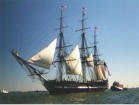 1492
AD: Hempen sails, caulking and rigging ignite
age of discovery and help Columbus and his ships reach America.
Many puritans follow over the next few centuries.
1492
AD: Hempen sails, caulking and rigging ignite
age of discovery and help Columbus and his ships reach America.
Many puritans follow over the next few centuries.
1545:
Hemp agriculture crosses the continent overland to Chile. Dutch
achieve Golden Age through hemp commerce. Explorers find 'wilde
hempe' in North America.
1564:
King Phillip of Spain orders hemp grown throughout his empire,
from modern-day Argentina to Oregon.
1616-1654:
Nicholas Culpepper (1616-1654), listed a variety of medical uses
of the common european hemp (Cannabis sativa), including anti-inflammatory,
analgesic, and antiparasitic activity
1620:
Mayflower carried the Pilgrim Fathers to New Plymouth. America
beckons to many religious groups looking for a new start for their
followers to escape persecution or worldliness.
1630:
John Winthrop and many Puritans migrate to America
1631: Hemp
used as money throughout American colonies.
1636: Harvard
founded by Puritans
1762:
In the U.S. the state of Virginia rewarded farmers with bounties
for hemp culture and manufacture, and imposed penalties upon those
who did not produce it. George Washington grew hemp for fibre
and recreational use, and Thomas Jefferson acquired the first
American patent for his hemp break, a device used to separate
the hemp stalk into usable hurds and fiber with greater speed
than the retting of past. Without hemp America could not have
successfully waged the revolution, and for the next one hundred
and fifty years hemp enjoyed the position as America's top cash
crop.
1772: Samuel
Taylor "Estese" Coleridge born in England. Writes beautiful
poetry, but spends his life battling opium addiction. (1772-1834)
1807:
Czar Alexander of Russia was forced to sign the treaty of Tilser,
which cut off all legal Russian trade with Great Britain, its
allies, or any other neutral nation ship acting as agents for
Great Britain. Napoleon hoped to stop Russian hemp from reaching
England, thereby destroying Britains navy by forcing it to cannibalise
sails, ropes and rigging from other ships; Napoleon belived that
Britain, starved of hemp, would be forced to end its blockade
of France and the continent. As a result of Napoleons actions,
hemp, which normally sold at twenty five pounds per tonne, reached
a price of one hundred and eighteen pounds per tonne in 1808.
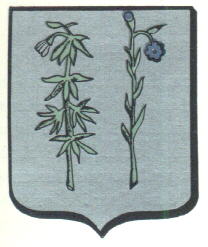 1818:
The old (left) coat of arms for the Belgian town of Hamme was
granted on January 31, 1818 and confirmed on May 13, 1913. The
arms show on the right half a branch of a hemp plant and on the
left half a branch of a flax plant (with blue flower). Both were
important crops in the early 19th century. Hemp was used for ropes,
flax for linen.
1818:
The old (left) coat of arms for the Belgian town of Hamme was
granted on January 31, 1818 and confirmed on May 13, 1913. The
arms show on the right half a branch of a hemp plant and on the
left half a branch of a flax plant (with blue flower). Both were
important crops in the early 19th century. Hemp was used for ropes,
flax for linen.
1822:
Thomas De Quincy published "Confessions of an English Opium
Eater", which became his masterpiece. In addition, he wrote
numerous essays on political, social, critical, historical and
philosophical subjects.
1839:
The first Opium War between Great Britain and China. Early in
the 19th cent., British merchants began smuggling opium into China
in order to balance their purchases of tea for export to Britain.
In 1839, China enforced its prohibitions on the importation of
opium by destroying at Guangzhou (Canton) a large quantity of
opium confiscated from British merchants. Great Britain, which
had been looking to end China's restrictions on foreign trade,
responded by sending gunboats to attack several Chinese coastal
cities. China, unable to withstand modern arms, was defeated and
forced to sign the Treaty of Nanjing (1842) and the British Supplementary
Treaty of the Bogue (1843). These provided that the ports of Guangzhou,
Jinmen, Fuzhou, Ningbo, and Shanghai should be open to British
trade and residence; in addition Hong Kong was ceded to the British.
Within a few years other Western powers signed similar treaties
with China and received commercial and residential privileges,
and the Western domination of China's treaty ports began.
1842:
Baudelaire, 19th century French poet, translator, and literary
and art critic, received his inheritance in April 1842 and rapidly
proceeded to dissipate it on the lifestyle of a dandified man
of letters, spending freely on clothes, books, paintings, expensive
food and wines, and, not least, hashish and opium, which he first
experimented with in his Paris apartment at the Hôtel Pimodan
(now the Hôtel Lauzun) on the Île Saint-Louis between
1843 and 1845.
1847:
Mormons settle in Utah under Brigham Young, after years of moving
around since beginning in New York with Joseph Smith's vision
around 1830.
1850: Tree-pulp
papermaking becomes more cost-effective than hemp through the
rise of assembly line manufacturing methods.
Hemp continues to be used for rope, birdseed, and other products.
Constant efforts to improve hemp and hemp products by producers
and others.
The Gold Rush brings many Chinese.Opium seen as a Chinese drug.
Racism enters the equation.
 1856:
The second Opium War broke out following an allegedly
illegal Chinese search of a British-registered ship, the Arrow,
in Guangzhou. British and French troops took Guangzhou and Tianjin
and compelled the Chinese to accept the treaties of Tianjin (1858),
to which France, Russia, and the United States were also party.
China agreed to open 11 more ports, permit foreign legations in
Beijing, sanction Christian missionary activity, and legalize
the import of opium. China's subsequent attempt to block the entry
of diplomats into Beijing as well as Britain's determination to
enforce the new treaty terms led to a renewal of the war in 1859.
This time the British and French occupied Beijing and burned the
imperial summer palace (Yuan ming yuan). The Beijing conventions
of 1860, by which China was forced to reaffirm the terms of the
Treaty of Tianjin and make additional concessions, concluded the
hostilities.
1856:
The second Opium War broke out following an allegedly
illegal Chinese search of a British-registered ship, the Arrow,
in Guangzhou. British and French troops took Guangzhou and Tianjin
and compelled the Chinese to accept the treaties of Tianjin (1858),
to which France, Russia, and the United States were also party.
China agreed to open 11 more ports, permit foreign legations in
Beijing, sanction Christian missionary activity, and legalize
the import of opium. China's subsequent attempt to block the entry
of diplomats into Beijing as well as Britain's determination to
enforce the new treaty terms led to a renewal of the war in 1859.
This time the British and French occupied Beijing and burned the
imperial summer palace (Yuan ming yuan). The Beijing conventions
of 1860, by which China was forced to reaffirm the terms of the
Treaty of Tianjin and make additional concessions, concluded the
hostilities.
Opium in anglo-saxon countries was sometimes referred
to as "a filthy Chinese practice". This seems highly
hypocritical when it was the west that forced Opium upon them
to maintain Tea supplies.
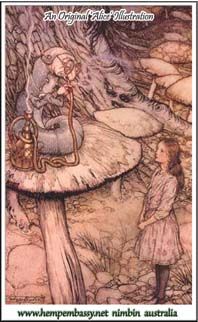 1865:
"Alice's Adventures in Wonderland" was
published in 1865, by Rev. Charles Lutwidge Dodgson, an English
writer and brilliant mathematician, under the pen-name he had
first used some nine years earlier - Lewis Carroll.
"Through the Looking Glass" followed.Although he spent
so much of his life in the academic environment, Dodgson's real
passions were always artistic. He loved the theatre and the company
of 'theatricals'. He loved artists and their work. He courted
the bohemian life in a way that sometimes compromised the required
dignity of his position as an Oxford don. Earlier, in 1861 he
had become a deacon of the Anglican church, but, despite his religious
background, and in direct defiance of the laws of his college,
he refused to become a priest. Through the image of the caterpillar
with a hookah he will forever be associated with cannabis.
1865:
"Alice's Adventures in Wonderland" was
published in 1865, by Rev. Charles Lutwidge Dodgson, an English
writer and brilliant mathematician, under the pen-name he had
first used some nine years earlier - Lewis Carroll.
"Through the Looking Glass" followed.Although he spent
so much of his life in the academic environment, Dodgson's real
passions were always artistic. He loved the theatre and the company
of 'theatricals'. He loved artists and their work. He courted
the bohemian life in a way that sometimes compromised the required
dignity of his position as an Oxford don. Earlier, in 1861 he
had become a deacon of the Anglican church, but, despite his religious
background, and in direct defiance of the laws of his college,
he refused to become a priest. Through the image of the caterpillar
with a hookah he will forever be associated with cannabis.
1869:
The Prohibition Party is formed. Gerrit Smith, twice Abolitionist
candidate for President, an associate of John Brown, and a crusading
prohibitionist, declares: "Our involuntary slaves are set
free, but our millions of voluntary slaves still clang their chains.
The lot of the literal slave, of him whom others have enslaved,
is indeed a hard one; nevertheless, it is a paradise compared
with the lot of him who has enslaved himself to alcohol."
[Quoted in Sinclar, op. cit. pp. 83-84]
1874:
The Woman's Christian Temperance Union is founded in Cleveland.
In 1883, Frances Willard a leader of the W.C.T.U. forms the World's
Woman's Christian Temperance Union.
1882:
Laws in the United States, and the world, making "temperance
education" a part of the required course in public schools
are enacted.
The Personal Liberty League of the United States is founded to
oppose the increasing momentum of movements for compulsory abstinence
from alcohol. [Catlin, op. cit. p. 114]
1886:
Congress makes temperance education mandatory in the District
of Columbia, and in territorial, military, and naval schools.
By 1900, all the states have similar laws. [Crafts et. al., op.
cit. p. 72]
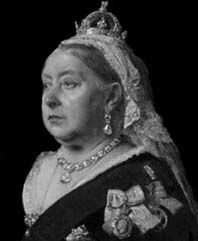 1890:Queen
Victoria"s personal physician, J.R. Reynolds described it
in 1890 as "One of the most valuable medicines we possess."
In another Lancet article published in 1890, he described the
use of cannabis indica for treating insomnia in the senile, alcoholic
delerium, neuralgia, migraine, spastic paralysis, and convulsions.
He allegedly prescribed tincture of cannabis to Queen Victoria.herself
for the treatment of menstrual cramps. Cannabis tincture and an
extract made from resin were available from Peter Squire of Oxford
St in 1864, and wholesale through the Society of Apothecaries
by 1871. Chemists extracted stuff they called cannabene, cannabin
tannin, cannabinnene etc but had no idea which, if any, was the
"active ingredient" until cannabinol was isolated in
1895. THC was not isolated until 1964.
1890:Queen
Victoria"s personal physician, J.R. Reynolds described it
in 1890 as "One of the most valuable medicines we possess."
In another Lancet article published in 1890, he described the
use of cannabis indica for treating insomnia in the senile, alcoholic
delerium, neuralgia, migraine, spastic paralysis, and convulsions.
He allegedly prescribed tincture of cannabis to Queen Victoria.herself
for the treatment of menstrual cramps. Cannabis tincture and an
extract made from resin were available from Peter Squire of Oxford
St in 1864, and wholesale through the Society of Apothecaries
by 1871. Chemists extracted stuff they called cannabene, cannabin
tannin, cannabinnene etc but had no idea which, if any, was the
"active ingredient" until cannabinol was isolated in
1895. THC was not isolated until 1964.
1893:
German inventor Rudolph Diesel published a paper entitled "The
Theory and Construction of a Rational Heat Engine," which
described an engine in which air is compressed by a piston to
a very high pressure, causing a high temperature. Fuel is then
injected and ignited by the compression temperature. Intended
fuel is vegetable and seed oils. Vision of a "people's engine"
Petrochemical industry does not encourage this view, and see's
alternative use of seed oils instead of gasoline as threat to
future sales.
1894:The
Indian Hemp Drugs Commission Report (1894) to the British government,
comprising some seven volumes and 3,281 pages, is by far the most
complete and systematic study of marijuana undertaken to date.
Because of the rarity and, perhaps, the formidable size of this
document, the wealth of information contained in it has not found
its way into contemporary writings on this subject. This is indeed
unfortunate, as many of the issues concerning marijuana being
argued in the United States today were dealt with in the Indian
Hemp Drugs Commission Report.
http://www.druglibrary.org/schaffer/Library/effects.htm
"Viewing the subject generally, it may be added
that the moderate use of these drugs is the rule, and that the
excessive use is comparatively exceptional. The moderate use practically
produces no ill effects. In all but the most exceptional cases,
the injury from habitual moderate use is not appreciable. The
excessive use may certainly be accepted as very injurious, though
it must be admitted that in many excessive consumers the injury
is not clearly marked. The injury done by the excessive use is,
however, confined almost exclusively to the consumer himself;
the effect on society is rarely appreciable. It has been the most
striking feature in this inquiry to find how little the effects
of hemp drugs have obtruded themselves on observation. The large
number of witnesses of all classes who professed never to have
seen these effects, the vague statements made by many who professed
to have observed them, the very few witnesses who could so recall
a case as to give any definite account of it, and the manner in
which a large proportion of these cases broke down on the first
attempt to examine them, are facts which combine to show most
clearly how little injury society has hitherto sustained from
hemp drugs " : From the report.
The English approach was that if people were doing
something you didn't want them to, that wasn't covered by the
commandments, you taxed it and made it expensive. Putting them
in jail would only cost the government to no benefit.
1895: Cannabinols
isolated and extracted.
1900: Diesel
runs his engine on peanut oil at World's Fair.
1909:
Shanghai International Opium Conference was held at the
insistence of USA, supported by European powers, China, Japan,
Siam and Persia.
1911:
An Opium Conference at the Hague drafted the first treaty which
attempted to control opium and cocaine through world wide agreement.
1912:
Hague International Convention on
Narcotics - control production and distribution of raw and prepared
opium (morphine and cocaine); required parties to Convention to
‘examine possibility of making it a penal offence to be
in illegal possession of’ drugs covered by the treaty.
1915:
Utah passed the first state anti-marijuana law. Mormons who had
gone to Mexico in 1910 returned smoking marijuana. It was outlawed
at a result of the Utah legislature enacting all Mormon religious
prohibitions as criminal laws.
1917:
George W. Schlicten patented the Hemp Decorticator;
a farm-machine that mechanically separates the fibre in the Hemp
stalk. Heralds serious threat to wood pulping industry.
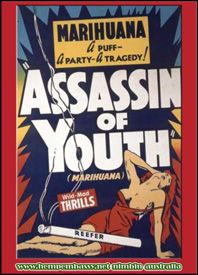 1920:
In England the Dangerous Drugs Act came into force.
Of interest here is that while the Americans also outlawed the
use of heroin for medical purposes, the English upheld this usage
and even found the provision of opiates, in this case heroin,
to addicts to be acceptable medical practice.
1920:
In England the Dangerous Drugs Act came into force.
Of interest here is that while the Americans also outlawed the
use of heroin for medical purposes, the English upheld this usage
and even found the provision of opiates, in this case heroin,
to addicts to be acceptable medical practice.
The Hague treaty of 1912 was 'as leaky as a sieve'
because it allowed the states to determine for themselves when
and how they would fulfil their obligations with regard to opium,
which of course kept the use of opium legal until that time. The
chemical derivatives did, however, fall under this· commitment:
their use was illegal, making these substances more than opium
the object of the battle. To make this battle more effective the
League of Nations held two conferences which led to two Geneva
Conventions: one of 11 February and one on 19 February 1925.
Also around this time,William Randolph Hearst,
media mogul, billionaire and model for Orson Welles' "Citizen
Kane", campaigns against new drug "marijuana".
Most didn't realise Hemp was the same thing. His aggressive efforts
to demonize cannabis were so effective, they continue to colour
popular opinion today.
Hearst owned a good deal of timber acreage; one
might say that he had the monopoly on this market. He also had
paper-mill holdings, and a national network of newspapers and
magazines to spread wildly inaccurate and sensational stories
of the evils of cannabis or "marihuana". Other tabloids
jumped on the bandwagon, printing similar stories about crazed
mexicans and negros committing hienous crimes under the influence
of marihuana.
The sheer number of newspapers, tabloids, magazines and film reels
that Hearst controlled enabled him to quickly and effectively
inundate American media with his propaganda. Hearst preyed on
existing prejudices by associating cannabis with Mexican workers
who he said threatened to steal American jobs and also African-Americans.
With no strong voice to the contrary, Hearst was persuasive in
his appeal to prejudice.
Hearst was not alone in his efforts to destroy hemp production.
He had allies.
The new techniques would also make hemp a more viable
option for fabric and plastics. DuPont chemicals,
which at this time specialized in the chemical manufacturing of
synthetic fibre and plastics, and chemicals used in the process
of pulping paper might have seen hemp products as competition.
Hearst and Lammont DuPont had a
multi-million dollar deal in the works for a joint papermaking
venture. These two moguls, together with DuPont's banker,
Andrew Mellon, combined and co-ordinated their efforts
to demonise "marijuana".
Hearst's "yellow journalism" campaign
(so called because the paper developed through his and DuPont's
methods aged prematurely) and the 1930 appointment of
Mellon's nephew-in-law, Harry J. Anslinger, to Commissioner
of the newly created Federal Bureau of Narcotics put them in control
of US Federal drugs policy.
1925: Geneva
Convention adds cannabis to Hague Convention narcotic list
at the urging of the South African colonial government.
A permanent Central Opium Board to supervise international trade
in controlled drugs is set up.
1930:
The (Federal) Bureau of Narcotics
(FBN) was established in July that year when President Herbert
Hoover appointed that same Harry J. Anslinger
its first Commissioner of Narcotics, a position he held under
four U.S. presidents, spanning more than three decades.In meetings
with hemp industry representatives tells them any new laws wont
affect legitimate hemp producers.
Anslinger never tires of the "marihuana
causes death, murder, and insanity" line the whole time he
is in office. He has had more influence on Federal US Drug Policy
than any other.
1931:
Convention on the Limitation Period in the International Sale
of Goods (New York) - signatories to give estimates of legitimate
controlled drug needs. Embargoes against signatories exceeding
estimates.
1933: At
5:32 P.M. on December 5, 1933, Utah became the required 36th state
to ratify the 21st Amendment, thus officially ending National
Prohibition. Alcohol controls were gone, but those on
other drugs remained in place.
1937:
Marijuana Tax Act - $1.00 on every hemp transaction regardless
of size, and a mountain of paperwork to be filled in, passed on
Anslinger's brief advice. Crippling blow to reviving hemp industry.
Sterilised seed for birdfeed exempted from definition of Marihuana,
because this was only irreplaceable use of hemp that was acknowledged.
Nothing else adds condition to a bird, or helps them sing, like
hempseed. Read the Marijuana Tax Act at: http://www.druglibrary.org/schaffer/hemp/taxact/mjtaxact.htm
Dupont files patent for nylon.
Sunrise industries proclaim product advantages,
gain preferential treatment as "the next big thing",
and try to gain commercial advantage over competitors. The petrochemical,
drug, and woodpulp paper industries all competed with Hemp products.
In the first half of the twentieth century, one
of the few sane voices that spoke out against the de-hemping of
America through the Marijuana Tax Act of 1937, was Ralph Loziers
of the National Oil Seed Institute, who testified to the unhearing
members of the Tax Act committee that "hemp seed... is used
in all the Oriental nations and also in a part of Russia as food.
It is grown in their fields and used as oatmeal. Millions of people
every day are using hemp in the orient as food. They have been
doing that for many generations, especially in periods of famine....".
As Loziers noted, it wasn’t just the possibilities of an
important food industry which would be squashed by the Marijuana
Tax Act, but also the paint and varnish industry would be greatly
affected as hemp seed oil was a valuable drying agent and in the
two years prior to the installation of the Tax Act 179 million
pounds of hemp seed had been imported into the US for this purpose
alone. Anslinger said his few words, the same ones, and the Bill
was passed.
1938:
“New Billion-Dollar Crop” article published by Popular
Mechanics. This article revealed the details of the new machine
that removed the fibre from the stalk thereby drastically reducing
the human labour factor.It has been suggested that this machine,
the now fully developed decorticator, would have reduced the value
of the vast timberlands owned by Hearst for pulping and further,
reduced chemical sales by DuPont for pulp papermaking.
"Assassin of Youth" by H. J. Anslinger
& Cortney Riley Cooper published. It is a scaremongering diatribe
based on an earlier pamphlet by Anslinger.
"Its first effect is sudden, violent, uncontrollable
laughter; then come dangerous hallucinations -space expands -
time slows down, almost stands still....fixed ideas come next,
conjuring up monstrous extravagances...leading finally to acts
of shocking violence, ending often in incurable insanity."
(opening lines...)
Movie called "Marijuana - Assassin Of Youth"
made with Luana Walters, Arthur Gardner, Fay McKenzie, Michael
Owen, Dorothy Short, Dorothy Vaughan, Earl Dwire, Fern Emmett,
Henry Roquemore, Hudson Fausset, Eddie Johnson, Gay Sheridan,
Directed by Elmer Clifton, Writing credits: Charles A. Browne,
Elmer Clifton (story), Leo J. McCarthy
Hilarious exploitation scare film showing good girls turning into
fiends after smoking wacky weed. Some versions had the moonlight
nude scenes cut. A.K.A. "Assassin of Youth."
http://www.reefermadness.org/propaganda/rthages.html
(More propaganda quotes)
"Reefer Madness" movie released.
Canada prohibits production of hemp under Opium
And Narcotics Control Act.
1940: "Devil's
Harvest" movie released.
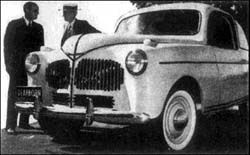 1941:
Henry Ford demonstrates hemp-fibre bodied car.[Similar product
to fibreglass]
1941:
Henry Ford demonstrates hemp-fibre bodied car.[Similar product
to fibreglass]
1942: Japanese take
the Phillipines, cutting off America's supply of imported Manilla
Hemp products. "Hemp for Victory" Campaign
to encourage farmers to cultivate hemp. Exemption from active
duty one of the incentives.
1943:
"Marihuana, Assassin of Youth, Feeding the God Moloch",
by the Rev. Robert Devine published.
1955:
US Hemp farming again banned.
For some time America even
denied it had ever happened, until embarassing evidence came into
the public domain, forcing an admission.
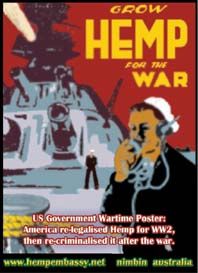 1961:
United Nations Single Convention on Narcotic Drugs
adopted at America's urging. Because of international resistance,
the penal measures eventually adopted are moderate and devised
to avoid conflict with the different legal systems of the Parties.Other
countries are increasingly required to adopt Federal U.S. style
drug laws. Marihuana is still classed as a narcotic.
1961:
United Nations Single Convention on Narcotic Drugs
adopted at America's urging. Because of international resistance,
the penal measures eventually adopted are moderate and devised
to avoid conflict with the different legal systems of the Parties.Other
countries are increasingly required to adopt Federal U.S. style
drug laws. Marihuana is still classed as a narcotic.
1963:
Anslinger finally steps down after 33 years of shaping and enforcing
US drug policy.
1964: THC
isolated in vitro. The extremely delicate and costly equipment
needed to manufacture it has left THC solely in the hands of professional
laboratories under regulated, contract to a limited number of
bona-fide drug researchers.
1965:
Teenage Baby Boomers experiment with drugs. Pot invades white
america. Flower Power and Hippies challenge cultural assunptions.
1971:
United Nations Convention on Psychotropic Substances.
The major novelty in these two conventions was the attention to
providing facilities for medical treatment, care and rehabilitation
of addicts. Moreover, as Western social attitudes towards drug
use became more relaxed in the 1960s and 1970s, the search for
more effective non-penal methods of treating and rehabilitating
drug users resulted in a more elastic interpretation of international
obligations by some states.
However, this did not result in a fundamental change. On the contrary,
under the influence of the United States, law enforcement co-operation
became a priority for the UN. When, by the mid-1980s, the problem
of money laundering grew, so did the growth of the global consciousness
of the dangers of the illicit traffic and the need for greater
international co-operation.This lead to the 1988 Convention.
1975:
Colorado decriminalises on the first of July.
1976: California
decriminalises on New Years day. Minnesota follows on the fourth.
Ohio in November. Maine decrininalises.
1977:
New York state decriminalises in July.
1978:
By now California, Colorado, Maine, Minnesota, Mississippi, Nebraska,
Nevada, New York, North Carolina, Ohio and Oregon -- have in effect
decriminalized minor marijuana offences. Some recriminalise after
a year or so leaving nine states
In Holland a new policy option is introduced, that
of toleration. This implies that activities that in themselves
are punishable by law are nevertheless allowed to continue, if
the policy makers decide that this option causes less harm. This
will be decided on a local level, in a meeting of the major, chief
of the police and the public prosecutor. So called "house
dealers" had been dealing cannabis in youth centres in the
years before, but now the decision can be made to allow them to
do their job. Furthermore, coffee shops emerge, shops that do
sell coffee, tea and soft drinks (in some cases alcoholic drinks
also), but whose ultimate reason for existence is the sale of
cannabis products. These too are generally left alone, unless
they violate the regulations that have been established by the
local authorities. The status of these regulations is a curious
one: they are binding on a local level, but do not have the force
of law. The result is that regional differences in policy crop
up and continue to exist till today.
1981:
Alaska decriminalises.
1988:
United Nations Convention against Illicit Traffic in Narcotic
Drugs and Psychotropic Substances.
1991:
Alaska recriminalises, but court challenge stymies change.
Dutch policy towards the coffee shops is formalised,
along the lines that were developed in Amsterdam. Coffee shops
are not allowed to advertise their trade, sell hard drugs, be
the cause of nuisance, sell to youngsters under 18 (in some municipalities
this age is 16) or sell wholesale. What "advertising"
means precisely differs from one municipality to the next. In
1994 the criteria are standardised even more: the age limit becomes
18, advertising is better circumscribed. The maximum amount of
cannabis that can be sold per customer is set at 30 grams - and
dropped to 5 grams in 1996. Local differences still exist in the
number of coffee shops allowed and in the sale of alcohol on the
premises.
Visit http://www.a-klinikka.fi/transdrug/resources/nl_policy_article.html#Recent%20history%20of%20Dutch%20drug
for a very well written and reasoned overview of Dutch Drug Policy.
Now why couldn't Australia be this clued up?
1996: Oregon
recriminalises.
1998:
Oregon decriminalises again....
2001:
Nevada decriminalises.
2003: Canada
passes medical marijuana bill, forced to supply patients by courts.
Due to unworkability of existing marihuana laws cannabis decriminalised
to end legal deadlock. New US Federal Drug Czar appalled, makes
veiled threats, but will not attend Canadian enquiry to argue
against it.
UK and Switzerland move to decriminalise.
After an appeals court found an initiative to decriminalise
cannabis valid, Alaska voters will have a chance to vote for decriminalization
on the 2004 ballot. But it may be a moot point, given last month's
appeals court ruling that there is no law against marijuana possession
in the home in Alaska.
US Supreme Court refuses to deny doctors the right
to suggest cannabis. Declines the case on basis of free speech.
Feds wanted ruling denying right to even suggest it. Nine states
are decriminalised, and thirty five states have passed legislation
recognizing marijuana's medicinal value. But federal law bans
the use of pot under any circumstances.
http://www.thc.nl/Documents/legislatableEU.htm#Spain
(Comparison of European Drug Laws)
Today:
The Federal American government is still trying to stop the world
from smoking pot, even for medical purposes as authorised by some
of its own state legislatures.
Australia is party to these treaties and has similar
laws, though some Australian states have altered or are thinking
of altering them. Some Euopean nations are changing their laws.
Some U.S. states have long refused to conform to their federal
model too. Essentially, this is also a consequence of the United
States Federal Government's continuing desire to gain greater
power than that granted to it under the American Constitution,
both over it's own states, and the rest of the world.
"The reasons the pro-marijuana lobby
wants marijuana legal have little to do with getting high, and
a great deal to do with fighting oil giants like Saddam Hussein,
Exxon and Iran. The pro-marijuana groups claim that hemp is such
a versatile raw material that its products not only compete with
petroleum, but with coal, natural gas, nuclear energy, pharmaceutical,
timber and textile companies. It is estimated that methane and
methanol production alone from hemp grown as bio-mass could replace
90% of the world's energy needs. If they're right, this is not
good news for oil interests, and could account for the continuation
of marijuana prohibition." Hugh Downs, (US) ABC Radio Network
journalist.
There is that, but I have tried the legal drugs,
and some illegal ones, and the one I find least harmful is Cannabis.
I'd prefer to see it legal. The furore around it is out of all
proportion. The humble plant has aroused some obscure, but powerful
fear in conservative forces. None of them can say clearly why
or how marihuana is evil, but take it as a tenet of some common
faith without question.
What is this automatic alarm, and how do we
turn it off? (Editor)
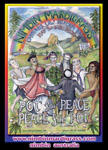 The
Nimbin MardiGrass Law Reform Rally
will be held on the First Sunday
in May every year to encourage Australia to change
its laws, and for all to have a good time.
The
Nimbin MardiGrass Law Reform Rally
will be held on the First Sunday
in May every year to encourage Australia to change
its laws, and for all to have a good time.
Remenber, it is easier to argue with the wise, than
it is to argue with the ignorant. Stay cool.
http://www.hempembassy.net/
If you feel you have information that should be
included in this history, or that something is incorrect, feel
free to send that information and inclusion will be considered.......
Thank you for pot smoking and may the force be busy
elsewhere attending real crimes......
Mail the
Hemp Embassy
or
Go to:
AUSTRALIAN
HEMP HISTORY
ORIGINS
of NIMBIN MARDIGRASS